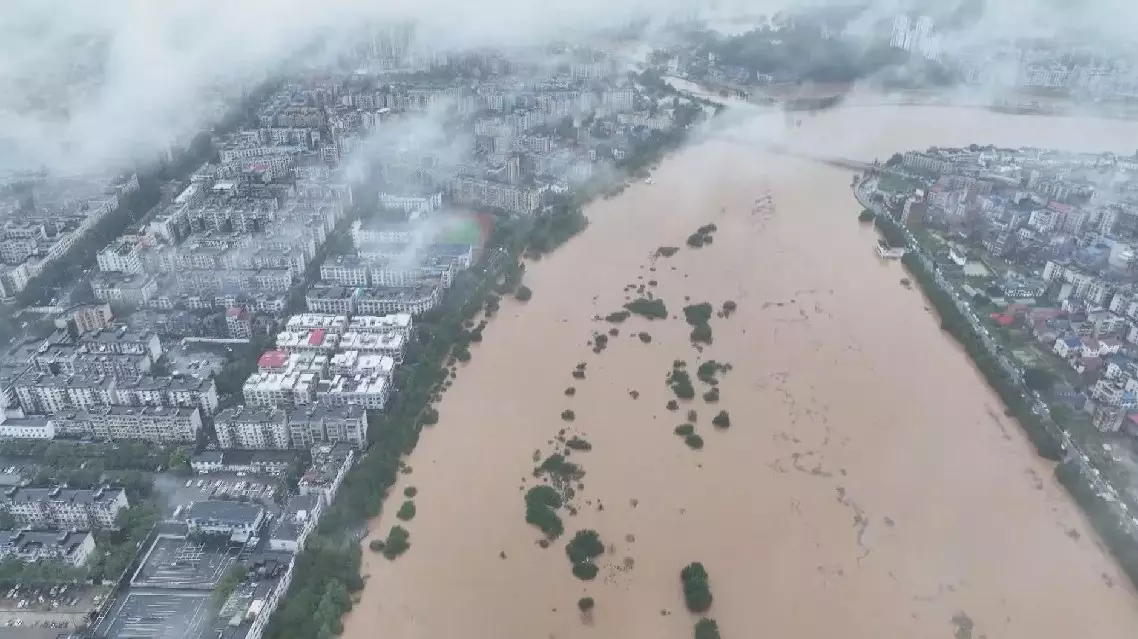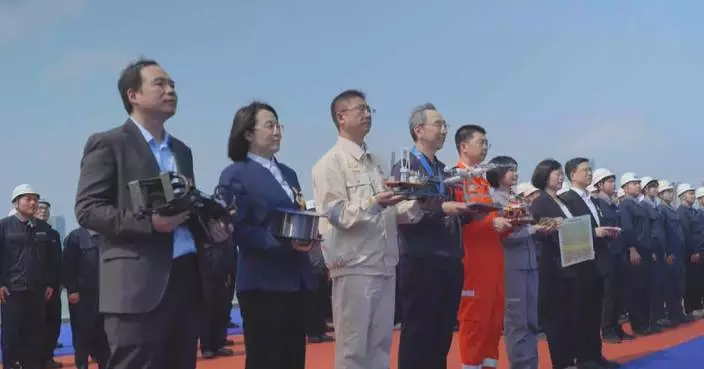Persistent heavy rainfall has led to rising water levels across the Yangtze River basin, creating significant flood control challenges for the areas along the main streams and tributaries.
The Three Gorges Reservoir, located upstream on the Yangtze in central China's Hubei Province, has been gradually reducing its discharge rate to alleviate pressure on downstream areas. On Thursday, the outflow was reduced from 24,000 cubic meters per second to 18,000 cubic meters per second and was further lowered to 14,000 cubic meters per second on Friday. This has caused the reservoir level to rise by approximately 2.9 meters, storing 1.46 billion cubic meters of floodwater.
One of the Yangtze's major tributaries, the Zijiang River in central China's Hunan Province, has also experienced significant flooding. The Shaoyang hydrological station recorded water levels exceeding the warning level, triggering the fourth flood event of this year on Zijiang.
The Miluo River, another river flowing through Hunan, flows from east to west into Dongting Lake before joining the Yangtze River. On Monday afternoon, the water level at the Pingjiang hydrological station on the Miluo River hit 77 meters, exceeding the warning level by about seven meters.
Torrential rains have affected over 200,000 people in Pingjiang County, with more than 1,000 roads and bridges damaged and public transportation disrupted. No casualties have been reported so far.
In east China's Anhui Province, the town of Huikou in Susong County is the first town the Yangtze enters as it flows into Anhui. Water levels at the Huikou hydrological station have been rising continuously, exceeding the warning level by about one meter by Monday afternoon. The water levels along the main course of the Yangtze River in the province have all exceeded the flood warning levels and continue to rise.
Additionally, 19 tributaries including the Shuiyang River, Chuhe River, and Xihe River have also surpassed their respective warning levels.

Yangtze River basin battles severe flooding after intense rainfall
U.S. tariffs on Cambodia, which were set at 49 percent, have sparked concerns among the Southeast Asian country's key export industries such as garment manufacturing amid the ensuing economic uncertainties.
On April 2, U.S. President Donald Trump announced the 49 percent "reciprocal tariff" on goods imported from Cambodia, the highest among all countries. Days later, the U.S. reduced the so-called "reciprocal tariff" to 10 percent for 90 days, offering a window period to Cambodia for negotiations with it.
Cambodian businesspeople say the tariffs have the potential to wreak havoc on the country's manufacturing sector, which, according to data from the World Bank, makes up around a fifth of the country's GDP.
"For U.S. manufacturers, definitely, there will be a big impact. If manufacturers are focusing on U.S. products, they are now in the middle. They don't know what they should do at the moment because the tariff now from Cambodia to the U.S. is actually quite high," said Dr. Ben Li, a Hong Kong investor in Cambodia and Chairman of the Cambodia Chinese Commerce Association.
Nevertheless, Li sees the tariff hike as an opportunity to export more Cambodian goods to the European Union, where a majority of Cambodian exports enjoy duty-free status.
"I always say there will be a light (at the end of the tunnel.) Even now, the U.S. tariff is so high, it's going to be so high after 90 days, we don't know. But, there's still a big market to Japan or to the European Union. There's still a big opportunity there," he said.
The Cambodian investor also believes the development of major infrastructure projects will help support Cambodia's economy.
"Especially the new canal and then the new airport, and the railways which connect to China. I believe once the logistics and infrastructure are built up, it can help the whole country's economy. By reducing the transportation costs, it can also mitigate the tariff costs," he said.
Cambodia and the U.S. held their first tariff negotiations on April 16, with more expected to follow. Local experts said the stakes are high for the country's workers.
"If this negotiation fails, there will be a significant impact. It will include the garment and travel goods sector. These sectors consist of about 1,068 factories and 930,000 workers. The income generated from these sectors is about 3 billion dollars per year. So it would significantly impact Cambodia's economy, jobs and incomes," said Chey Tech, a socio-economic research and development consultant from Dynamic Alliance Consulting.
Despite the potential risks, Tech expressed his optimism about a positive outcome, citing Cambodian Prime Minister Hun Manat's letter to Trump on April 4.
"The Prime Minister's letter confirmed that Cambodia would reduce the tariff rate for U.S. goods to 5 percent. Second, Cambodia is the least developed country. Third, Cambodia produces goods that the developed countries won't produce. We asked whether the U.S. would be able to produce these low-cost products. It cannot," said Tech.
In 2024, Cambodia exported goods of 9.9 billion dollars to the U.S., making it the country's largest market, accounting for 37 percent of Cambodia's total exports.

49-percent US tariffs sparks worry among Cambodia's key export industries




















































